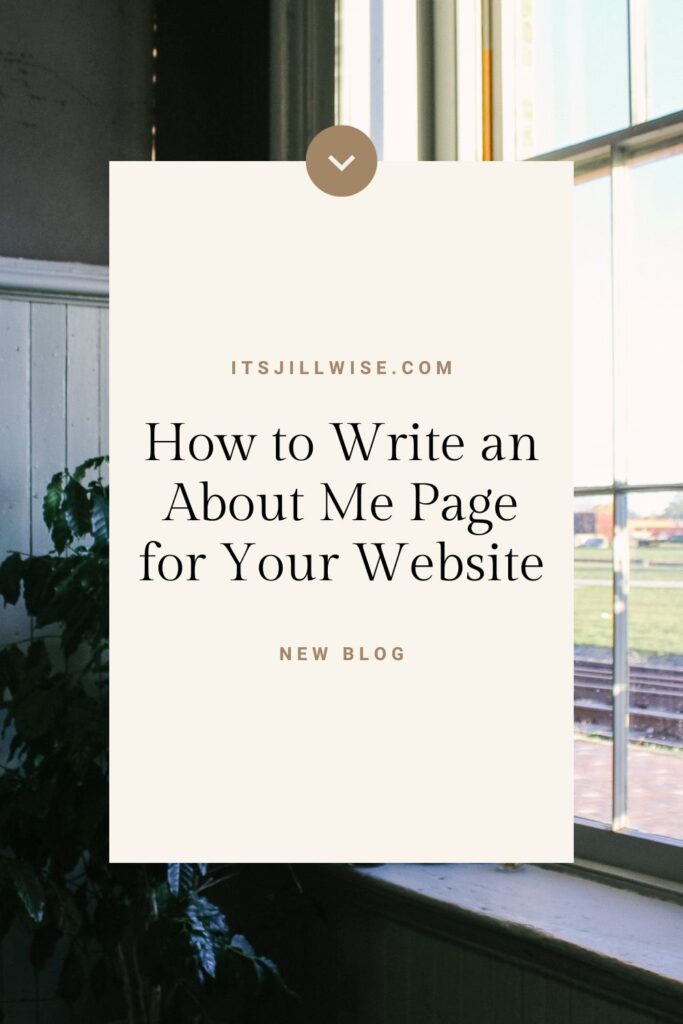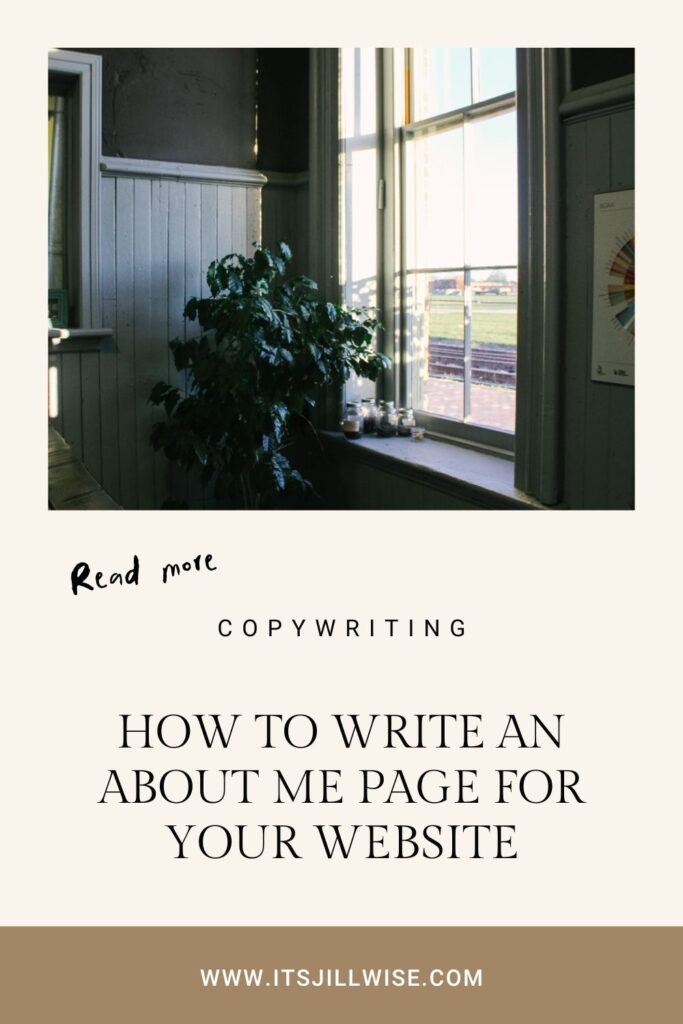Tips to write an about me page, from a conversion copywriter
I get it. Writing about yourself is one of the hardest things you will have to do when building your personal brand online. Where do you even start? What does your audience want to know? What can you say that will create a such a memorable first impression that your readers won’t waste a second to click buy, contact you, etc.? Don’t even get me started about how to write an about me page for your website…
Except actually, that’s what we’re talking about right now. Because if your about me page for your website isn’t working for you, there’s a big gap in your pipeline. Consumers are smarter than ever, and they want to feel connected in some way to the people, businesses, and brands they buy from. Trust sells. Period.
How does your about page play into that? A good about page for your website should show your ideal customers why you’re the best person to solve their problems. It tells a relatable story, inspires emotion, builds authority and credibility, and supports the offers on your website.
How do you do all that on your about page? Let’s answer that next.
In this blog post, we’re going to cover:
- How to treat your business like you would a client… if you’re a copywriter or freelance writer.
- The key components of a good about me page for your website.
- Step-by-step of how to write a good about me page for your website.
- Where to find website copywriting templates to make this project easier!

How to write copy for your website
When I first started writing copy for others, I didn’t even have a proper website of my own because I was too overwhelmed by the task of writing about myself. Then when I was ready to hire a brand and website designer, it still felt like a struggle because I wanted it to be perfect. It needs to be PERFECT, am I right?
There’s this additional pressure when you’re writing for your own business, especially if you work in the marketing world too. Not only is hard for all entrepreneurs to look at our own business logically and methodically… We’re too close to it to write impactful website copy sometimes. But if you work in the marketing world, it needs to be perfect because website words are marketing words, and this is supposed to be your thing. That’s so much pressure.
First, you need to know that you can do this. You are capable of writing website copy that works.
But we need to treat our businesses like we do our clients if we want to grow.
Just know that you aren’t alone in this challenge. Copywriting for websites obviously comes natural to me now after studying this for so many years, and writing copy for just as many. But I know it doesn’t for others, and that’s okay.

How to write an about me page for your website
Rule 1: Remember that it’s not about you
First things first, your about me page isn’t even really about you or your business. That’s right.
I know that sounds confusing. Stay with me… Your customers need to be at the center. Rather than writing about how amazing you are, it needs to focus on what they want or need, and how you can help them get that. They’re first. You’re the support they need. And you write through this customer-centric lens in order to make a real difference.
If you’re not sure what I mean, I’ve broken it down into 5 easy steps. You can use these to write your about page on your website whether you’re a blogger, a business owner, or need to write about your entire team.
How to write an about me page: What to include
When writing website copy, you always need to be aware of your target audience. Who do you want to reach? Next, you need to be clear on your goal for each page. What do you want your reader to do? What action should they take?
With these two key pieces of information in mind, it’s easier to write in a way that targets them specifically and encourages them to act. Each action is a conversion, which means your copy converts. What would it mean for your business and life if you could book calls with leads while you slept?
Here’s a brief list of sections, facts, and ideas to include on your about page…
A clear banner and headline
You need a banner and headline above the fold that identifies the reader. Let them know they’re in the right place. This headline can be a big promise, a strong statement that they can relate to, or a question that makes them think about what they want and why.
Remember that clear is better than clever, always.
A concise overview of their key challenges
While you don’t need to go into the same detail that you would on an offer or services page on your website, you can note challenges here. If you have multiple audience segments, you need to ensure your about page encompasses the big promise for all of them. What mission do you share with them? And why should they care?
Team or personal bio
Keep it brief! But yes, you should have a team or personal bio on your about page, of course. Sometimes I like to frame these as a key story in your overall message versus a traditional formulaic bio. Regardless of the style you choose, this should only include the information that is relevant to support your credibility and get them to check out your offers.
If you have a team, you should also consider including bios of the key players if applicable. You don’t need to share everyone, but the main points of contact are helpful as the face of the business.
Why you’re relevant to the problem they have.
Not always, but sometimes it’s a good idea to include a clear and compelling explanation of the solution you offer, and how. Sometimes these details are better suited on a services or offer page. But there are times when it’s relevant to note this on your about me page.
Typically, I lean more towards the overall mission statement rather than the value proposition of individual offers when writing about me pages for a website. But it’s something to keep in mind if it’s a good fit to include.
Branded images to better connect.
You need an image of yourself or your team. End stop. This helps create a connection because they can actually see who is behind the business. It’s personable and relatable.
Your photos don’t need to be professional right away if you’re just starting out, but they should be well-lit and look nice.
Call to action.
Don’t forget to put a call to action on your about page! This could be to check out your services, join your email list, etc. This might be easier to decide when you get to the design stage if there’s no clear spot to point your website visitors to.
How to write an about me page: The most important tip
Through the above, you want to focus on what makes your company culture or yourself unique. This is much easier to do after you complete the work to identify your brand’s core positioning points and messaging. You are special. You get to determine why that is, and share that story with your ideal audience.

How to write an about me page: 5 Simple Steps
Now that you have an overview of what to include on this page of your business’ website or blog, here’s the 5 steps to follow to write a compelling about me page that your clients will love!
1. Define your dream client
First, you need to get up close and personal with your target client. Who are they? What do they do? Where do they hang out? If you know someone in real life who fits the bill, don’t be shy to reach out to ask a few questions.
Write about your dream customer—dive into the nitty gritty details to create an avatar of them. Give them a name and traits. Outline their values. Decide where they work and what they do for fun. Everything helps!
Read: Identify your target audience
Most importantly, what does this person need from you? Do they have a problem that needs solving? A void that you can fill? Write out their specific challenge points.
2. Solve their problem
Once you know your perfect client inside and out, you should know how you solve their problem. You need to know exactly why your avatar wants to buy your product or service.
Write a list of the benefits you offer your avatar. Some get stuck in this stage because it’s a jump to start thinking outside of your own business. We’re all a little self-centered, especially when we live and breathe our livelihood. Remember how I said your about page isn’t even really about you? It’s about your target avatar and it’s likely that they are a little self-centered too.
Knowing this, instead of listing the fancy features of your product or service, think from the perspective of your avatar. What are the benefits they would experience from working with you? Save the bulk of this information for your product or services pages, but summarize for your about page.
3. Why are you special?
Now’s your chance to talk about you for a little bit. You’ve identified your target avatar, their problem, and the benefits of your solution, but what makes you so special anyways? Your ‘about’ page is your safe space to share your skills, qualifications, and accomplishments.
If you aren’t sure what to include here, try to think of the key points about you that differentiate you from your competitors. Show how your unique experience makes you the best person for the job. It’s okay to brag about your strengths when trying to convince a future client of your expertise. How will they know how good you are if you don’t just tell them?
4. Get a little personal
Next, refer to your notes that outline the personal traits of your perfect client. Play on this personality to amplify your similarities. Get real about why you think you would be a perfect business fit. For example, you could give them a glimpse into your own life by talking about what you like to do in your free time. Alternatively, your business growth story might be interesting, so include it! Tell them where you came from to showcase why you want to help. You will know what’s relevant to share if you’ve done the previous homework to define them.
A genuine connection can only happen if you make it a little bit personal.
Pro tip: Writing for the web is very different from writing for academia or for print. You can get personal with your tone as well. I typically write in an approachable tone, using shorter sentences and shorter paragraphs. Include explanations where necessary. However, keep it clear and snappy so your audience doesn’t get bored. And of course, keep the business’ brand voice in mind while writing.
It’s a balancing act between personality and professionalism. I lean to the more personal side, but that doesn’t work for everyone.
5. Ask for the action
Present your best self, then include a call to action to click to your contact information. Done and done.
Bonus tip: Always include a photo of yourself or your business team. Research shows that photos increase engagement. This Forbes article talks about the importance of including a photo on your LinkedIn profile. The same rules apply to your ‘about’ page.

How to write an about me page: Writer’s Block
You might get to a point where you feel stuck. You’re staring at a blank page wondering what to write on your about me page for your website. It happens to all of us at some point. The best way to move past it is to take the pressure off for your first draft to be perfect.
Copywriting has layers. The first is more about hitting the marks you need. It’s scientific. You can add your personality and flair in future drafts, but the first step should be to just hit the points required to convert your audience.
Still wondering how to write an about me page?
Cool. That’s what I’m here for. Really—if it were easy, I wouldn’t have a job. So if you want to DIY your website copy, but need more help figuring out what the heck to actually say, check out the Plug-In Website Copy Templates. Yes, there are about page copy templates in here too! These will accelerate the copywriting process for you because you won’t have to stress about what to say where. They have strategic, customizable copy prompts to guide you as you write.

These plug-in website copy templates are wireframed as well, so you not only know what to say, but where to say it. Design falls into place easily around it. Learn more here.
Related
Leave a Reply Cancel reply
Leave your info below to join the list. I send a lot of emails because people love to read them.
